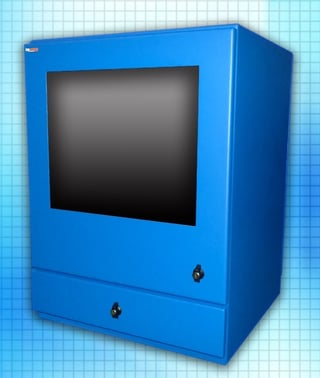In an industrial setting, protecting a computer, printer, monitor, keyboard, and related peripherals from dangers - like humidity, dust, grease, lint, dirt, and liquids - is a must!
When searching for the perfect enclosure solution, what specific details should a company consider? The enclosure options below are designed to point out critical issues to guide a company in determining which model and accessories will create the best solution.
Review these 8 Details to Find the Perfect PC Enclosure
STEP 1: ENVIRONMENT
Determine what type of environment the computer and expensive equipment will be located. Most likely, the enclosure solution will vary depending on if it is indoors vs. outdoors. Certain environments may require the computer enclosure to be fabricated out of a specific type of metal or steel. Dusty or dirty atmospheres will require a different enclosure construction, than areas that are exposed to splashing fluids, grease, or corrosive materials. These particulars will help to determine the proper NEMA rating (most common are 12, 4, 4X) for the desired enclosure. Bacteria may also be of concern, especially in the food and pharmaceutical industries. If so, a sloped top, stainless steel enclosure should be chosen over a carbon steel enclosure.
STEP 2: SIZE OF EQUIPMENT Compile a list of electronics; including the computer, printer, flat-panel monitor, and/or peripherals that need to be housed and protected inside of the pc enclosure. This will help the system integrator understand how much overall internal space will be needed to fit the equipment. Knowing what will be installed is just as important as the environment. If the desired electronics do not fit, then the enclosure is rendered useless. Perform the proper measurements of each item and compare it to the data sheet provided by the enclosure provider. Common enclosure types include freestanding units, desktop units, and wall mountable and pedestal mounted cabinets.
Compile a list of electronics; including the computer, printer, flat-panel monitor, and/or peripherals that need to be housed and protected inside of the pc enclosure. This will help the system integrator understand how much overall internal space will be needed to fit the equipment. Knowing what will be installed is just as important as the environment. If the desired electronics do not fit, then the enclosure is rendered useless. Perform the proper measurements of each item and compare it to the data sheet provided by the enclosure provider. Common enclosure types include freestanding units, desktop units, and wall mountable and pedestal mounted cabinets.
STEP 3: STATIONARY OR MOBILE
Determine if the equipment will need to be stationary, mobile, or a combination of both. This will dictate if the enclosure requires castors (lockable or swivel), be a fixed-floor/free-standing model, or installed on a pedestal. If the pedestal is adjustable vertically, multiple users will be able to adjust to a specific height, and thus provide a comfortable, ergonomic workstation.
STEP 4: THERMAL MANAGEMENT
Thermal management, cooling and/or heating, is a critical component for the equipment to perform well and will extend the lifetime of electronics. Consult a pc enclosure specialist to further understand if additional cooling or heating is necessary based on the installation environment. Important points to understand include the high and low ambient temperatures, as well as, the anticipated heat load of the equipment inside of the enclosure.
STEP 5: SECURITY
Security is a major area of concern for system integrators. Seeking an enclosure solution that is key lockable will prevent users from tampering with electronics and settings. Most enclosure suppliers provide lockable cabinets that are keyed the same, meaning a manager will only need one type of key to access the internal components of the unit. If a higher security measure is necessary, inquire with the enclosure representative to see if uniquely keyed cabinets are an option.
STEP 6: KEYBOARD/MOUSE
Many system integrators prefer the keyboard and mouse to be stored in a sealed drawer to prevent damage when not in use. Alternatively, it may be advantageous to let the keyboard and mouse reside on an external tray if the user will be accessing the computer the majority of the workday. If the installation is wet or corrosive, consider using an industrial NEMA rated keyboard and pointing device.
STEP 7: ACCESSORIES
What type of accessories will customize the enclosure to fit a specific company’s needs? Accessories to consider may include extra shelving, an external tray, bolt down legs, a folding mouse pad, a printer door, label slot/printer path, a cable entry gland, a surge protector, or an enclosure swivel. A variety of innovative and helpful accessories can be added to customize any enclosure!
STEP 8: POWDER COATING
What color will best fit the environment and also be aesthetically pleasing? Common products on the market are available in black, putty, blue, and gray. Customers often choose to have enclosures powder coated in a color that matches the company’s branding colors. Most enclosure providers offer custom colors cross referenced to the RAL color chart.
When deploying a pc enclosure in a manufacturing or industrial setting, these eight steps should be well-thought-out, in order to deploy an enclosure solution that will be successful for the long haul. Electronics stored or installed inside of an enclosure are usually essential to a company’s manufacturing process and, therefore, need to be protected. Always research every element of an enclosure solution. A faulty hinge, weak gasket, or cracked, flimsy window could mean vital electronics are exposed to damaging elements, such as splashing liquids. This could quickly destroy something that is critical to a company’s operation and will most assuredly cause costly downtime.
For More Information:
-The 3 Best Benefits of Computer Enclosures
-Determining the Value in Computer Enclosures
-3 Considerations for Computer Enclosures
-Defining NEMA Ratings for Computer Enclosures



